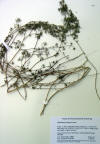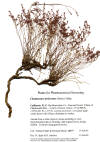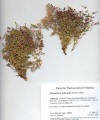|

Chamaesyce albomarginata
Inyo Co.: Hills at north end of Owens
Valley, north of Bishop, CA
Photo by Susan Spjut, May 2006 |
 Chamaesyce albomarginata
Kern Co.: south of California City near junction with Hwy 58, Oct 2007 |
|
 
Chamaesyce arizonica
AZ: La Paz Co., , road to Salome
NW of I-10,
Nov 2007
|
 Chamaesyce
celastroides
Kaua'i, Pu'u ka Pele Forest Reserve
Sep 2003 |
|

Chamaesyce maculata
Bakersfield, CA
weed in garden |

Chamaesyce parryi
El Paso Co., TX
Spjut 15027, Nov 2002 |
|
 
Chamaesyce micromera
CA: Imperial Co., CA.
Spjut 16154A, Oct 2007. Clay depressions in
creosote scrub, occurring as flat radial mats with another
prostrate species, Ch. serpyllifolia.
|
 
Chamaesyce polycarpa
Left: Chuckwalla Mts., Sonoran Desert, CA Spjut & Marin 14577.
Right: E of 29 Palms, CA. Spjut 15267 |
|

Chamaesyce prostrata
Bakersfield, CA
weed in garden
|
 
Chamaesyce serpyllifolia
AZ: Maricopa Co. N of Ajo along 85
Nov 2007 |
|
 
Chamaesyce serpyllifolia
CA: Imperial Co., CA
Spjut 16154B, Oct 2007.
Abundant along road margins and in sandy creosote flats.
|
|
|
Yang,
Y., R. Riina, J. J.
Morawetz, T. Haevermans, X. Aubriot and P. E. Berry. 2012.
Molecular phylogenetics and classification of Euphorbia subgenus
Chamaesyce (Euphorbiaceae). Taxon: 61:764–789.
“Euphorbia
subg.Chamaesyce
contains around 600 species and includes the largest New
World radiation within theOld World-centered genus Euphorbia. It
is one of the few plant lineages to include members with C3,
C4 and CAM photosyn-thesis, showing multiple adaptations
to warm and dry habitats. The subgenus includes North American-centered
groups thatwere previously treated at various taxonomic ranks under the
names of “ Agaloma ”, “Poinsettia
”, and “Chamaesyce”.
Here we
provide a well-resolved phylogeny of Euphorbia
subg.
Chamaesyce using nuclear
ribosomal ITS and chloroplast ndhF sequences, with substantially
increased taxon sampling compared to previous studies. Based on the
phylogeny, we discuss theOld World origin of the subgenus, the evolution
of cyathial morphology and growth forms, and then provide a formal
sectionalclassification, with descriptions and species lists for each
section or subsection we recognize.”
|